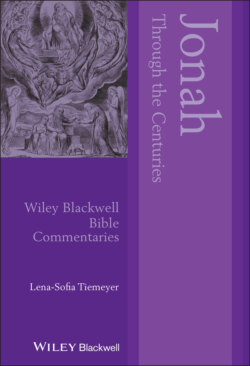Читать книгу Jonah Through the Centuries - Lena-Sofia Tiemeyer - Страница 12
Typology
ОглавлениеTo appreciate fully the Christian uses of the Book of Jonah, we must begin in the New Testament (NT). The NT mentions Jonah in Matt 12:38–41; 16:1–4 and in Luke 11:29–32, two of which refer to the so-called ‘sign of Jonah’ (Matt 12:39; Luke 11:29). The NT authors aim (among other things) to show how Jesus is the fulfilment and culmination of the Hebrew Bible/Old Testament (OT). Read from this perspective, the texts in the OT have been either fulfilled or superseded. Fulfilment is understood to take place broadly in the person of Jesus in a collective, corporate, and individual way.
This approach was further developed in patristic exegesis. Much of the writings of the Church Fathers focussed on the relationship between the OT and the NT, emphasizing either the dichotomy between the two testaments (e.g. Marcion), their identity and essential sameness (e.g. the Alexandrian Fathers), or the continuity and development between the OT and the NT, where a sound reading of the OT begins in the NT and works backwards (e.g. the Antiochene Fathers). Both the Alexandrian and the Antiochene Fathers use typology: the correspondence between people and events of the past, present, and future. Typology is based on the conviction that God acts consistently and that earlier acts of God ‘prefigure’ his later acts (e.g. Matt 24:37; in John 3:14). To the Church Fathers, an OT character can be a ‘type’, i.e. a prophetic image that points forward to and is fulfilled by Jesus Christ, or an ‘anti-type’, i.e. a figure or situation that is opposite to that found in the NT.
Christian exegetes took an active interest in the Book of Jonah, partly due to its typological potential. Among the Church Fathers, the interpretations of St Cyril of Jerusalem, Gregory of Nazianzus, Jerome, John Chrysostom, and Augustine stand out. The reformers followed suit. Luther, Bugenhagen, and Calvin each wrote a full-length treatise on the book. Their exegesis was informed by its typological aspects, but they also interpreted the book in a relatively literal manner with an eye to its relevance to the theological debates of their time.
The widespread Christian typological understanding of Jonah has its origin in the reference to the ‘sign of the prophet Jonah’ in Matt 12:39/Luke 11:30. There are three main typological events in Jonah’s life:
1 Jonah being tossed into the sea by the sailors is a precursor for Jesus’scrucifixion (Jonah 1:15).
2 Jonah’s three days inside the belly of the fish is a precursor for Jesus’sdeath (Jonah 2:1b).
3 Jonah being vomited out of by the fish is a precursor for Jesus’s resurrection (Jonah 2:10).
Beginning with the second and third points, the Church Fathers agree almost unanimously that the three days and the three nights in Jonah 2:1b point to Jesus’s death and resurrection (e.g. Augustine, Cyril of Jerusalem). In parallel, many patristic interpreters stress the distinction between Jonah and Jesus. Cyril of Alexandria highlights that not everything which befell Jonah should be understood as relevant and applicable to the process of seeing Jonah as a type for Christ. Jonah tried to flee from God’s command, unlike Jesus, who did not display any reluctance or lack of enthusiasm for his ministry, nor did he flee from the face of God. Furthermore, while Jonah was disappointed in God’s compassion, Jesus was not disappointed to see the nations saved. Thus, inherent in many of the typological interpretations is a sense that Jonah is an imperfect type or even an ‘anti-type’ of Christ, ultimately to be replaced by the perfect ‘true Jonah’, namely Jesus. This view became prevalent in much Christian writing and often conveyed anti-Jewish replacement theology.
Turning to the first point, many Christian exegetes (e.g. Jerome) treat the sailors as ‘anti-types’ and compare them to the Jews at the time of Jesus, to the detriment of the latter. Whereas the sailors hesitated to throw Jonah into the sea, the Jews at the time of Jesus shouted for Jesus’s crucifixion. Turning to the ‘types’, a significantly smaller group of Christian retellings, yet equally anti-Jewish in their outlook, depicts the sailors as brutal Jewish men ready and willing to kill Jonah.
In addition to these three main typological readings, many interpreters maintain the virtue of the people of Nineveh. Despite the brevity of Jonah’s message, they turned to the God of Israel in penitence. Many Christian exegetes use the Ninevites’ repentance to highlight the perceived failure of the Jews to accept Jesus as their Messiah (e.g. Jerome, Justin Martyr, Cyril of Alexandria, Ephrem the Syrian). This type of anti-Jewish comparison remains prevalent among the reformers. In his German commentary to Jonah, Luther lauds Nineveh’s behaviour, comparing it with that of the centurion in Matt 8:10, while lamenting Jerusalem’s rejection of Jesus. It also persists in later protestant sermons on Jonah. The eighteenth-century English congregational minister Thomas Bradbury, for example, contrasts the people of Nineveh with the people of Israel. The former believed Jonah – a mere messenger – and repented of their sins, whereas the latter neither believed nor repented despite hearing God’s own son in the flesh.
Finally, the worm in Jonah 4:7 has been read typologically to foreshadow Jesus’s victory on the cross and the triumph of the Gospel. According to Augustine, followed by Luther, the worm is a type for either Christ or the Gospel, who devours the plant (kikayyon), which represents the Old Covenant. Again, this image is strongly anti-Jewish in its insistence that God’s covenant with Israel has been superseded by that with the Christian Church.
